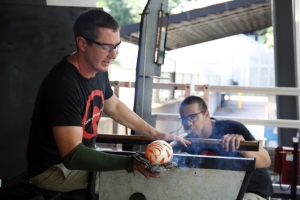The Allure of Liquid Fire: A Look at the Art and Craft of Glassblowing
by Kelly Englert
Glassblowing is an ancient and beautiful art form, used to create many common objects, and yet it is foreign to most people. The art requires training, the process can be dangerous, and the necessary equipment isn’t exactly available through your local art supply store.
Manipulation of glass requires a specific type of facility housing furnaces, specialized tools and a team of well-trained staff who are capable of operating the equipment and teaching others the skills required of this intense process. Pittsburgh is fortunate to have such a unique facility at the Pittsburgh Glass Center. I got in touch with Pittsburgh glass artist Zach Layhew, one of the instructors at PGC, to learn more about this beautiful art, how it works and what is unique about it.
Layhew learned about PGC in art class while attending Fox Chapel High School. Enrolling in a teen boot camp sparked his interest, and the intrigue of glassblowing took hold. The student has now become the teacher, and Layhew can be found leading workshops at PGC and working in the studio developing his portfolio. He is currently studying industrial design and aspires to study glass further in an academic program, hopefully leading to teaching at the university level.
Layhew is attracted to the danger aspect of the art: glass artists work in very close proximity to furnaces reaching temperatures upwards of 2150°F. The artist shapes the liquid glass into an object as it moves and shifts in the heat. “It’s very complicated and… it’s a kind of Zen thing too. The glass is going to do what it does naturally, but you have to force it and go and work with it to get it to look like what you want it to look like,” says Layhew.
The manipulation of glass is, in itself, a visually stunning process. The golden glow of enormous burning furnaces fills the studio. The molten glass is gathered onto the end of a long blowpipe like thick honey. One person holds and spins the pipe, with the glass end inside the furnace opening. Another person blows air into the pipe, which causes the glass to balloon into a hollow form on the other end.
Once the glass, still glowing with heat, is brought out of the furnace, it stays on the blowpipe and continues to be manipulated by spinning the pipe, now using hand tools, a steel table or gravity. The main tool is the jacks, a double bladed device used to shape the sides of an object. Sometimes the piece is shaped by spinning the glass on one’s own hand, with only wet newspapers in between the 1000°F glass and the artist’s skin.
After the glass has been shaped to the artist’s desire, it is placed inside an annealer, a large oven that allows glass to cool slowly, taking it from a very high temperature to a lower temperature gradually. Working with glass at such a high temperature requires coordination, strength, craftsmanship and a great deal of practice. Bringing it down to normal air temperature requires patience, for if one were to cool a piece in the open air, it would crack.
We all use glass every day for functional purposes. So in what context does it become art? At what point can we draw a line between art and craft?
Layhew feels the difference is in the concept. Glass becomes art when the creator of a piece is thinking outside the box, applying original ideas and making things that haven’t already been made. Any well-made piece certainly requires artistry, but becomes a work of art when conceptual creativity has been applied.
In Layhew’s own work, he takes a sculptural approach to creating pieces that are traditionally considered functional. He begins by sketching and painting to develop concepts for his pieces that are unexpected and “off the wall,” says Layhew. Instructors and teaching assistants at PGC have the option of earning credit for studio time instead of receiving monetary payment, which allows them to develop their own work in the studio while working for the Center. Currently, Layhew is developing a series of works that appear to be functional vessels, but are actually closed forms with pieces hanging inside the main body of the form.
Glassblowing is the most commonly known of the glass arts, but many other less-intensive processes are available at facilities where glass arts are offered. PGC offers plenty of classes and workshops for kids and teens 14 and up to make kid-friendly pieces – no danger required. For more information on the Pittsburgh Glass Center, visit pittsburghglasscenter.org.
If you are fortunate enough to live in a city with a glass center (and TMD will gladly share links to other glass centers if you post them here), I would highly recommend stopping by for a tour of the studio. Most art centers welcome beginners to any art with open arms, and you will likely find someone willing to give you a tour of the facility. But be forewarned: once you leave a blustery winter day outside to experience the heat of the furnace on your face, the glowing hot glass in your hands and the satisfaction of a piece of art you can call your own… you might never come out.











